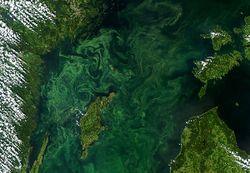Case studies eutrophication
Contents
Ecological impacts of eutrophication (case study: Eutrophication and dead zones)
Introduction
Dead zones are very low oxygen areas (hypoxic) in the ocean where marine life including fish, crabs and clams cannot survive. In the 1970s oceanographers began noting increased instances of dead zones. A 2008 study counted 405 dead zones worldwide[1]. Hypoxia is a natural phenomenon that occurs periodically in coastal waters around the world. During the last 50 years however, increases in key pollutants from human activities on land have thrown many coastal ecosystems out of balance, resulting in expanded dead zone regions.
Causes and consequences
Aquatic and marine dead zones can be caused by an increase in chemical nutrients (primarily nitrogen and phosphorus) in the water known as eutrophication. Major nutrient sources come from human activities such as the use of fertilizers in agriculture and the burning of fossil fuels. These nutrients lead to a rapid increase of the density of certain types of phytoplankton resulting in algal blooms. The organic matter prouced by these phytoplankton species at the surface of the ocean sinks to the bottom (the benthic zone) where bacteria break it down. The bacteria use oxygen and give off carbon dioxide during this breakdown. Fish and mobile invertebrates can migrate out of hypoxic areas. Plants and animals that are slow moving or attached to the bottom (seagrass, worms and clams) cannot escape from the dangers of hypoxic waters and will die.
The largest dead zone worldwide is the Baltic Sea[1]. Overfishing of Baltic cod has greatly intensified the problem. Cod eat sprats, a small, herring-like species that eat microscopic zooplankton that in turn eat the algae. So, fewer cods and an explosion of zooplankton-eating sprats means more algae and less oxygen- a vicious cycle develops [2].
Solutions
The main goal in reducing dead zones is to keep fertilizers on the land and out of coastal waters. The Black Sea dead zone largely disappeared between 1991 and 2001 after fertilizers became too costly to use following the collapse of the Sovjet Union and the demise of eastern European economies. Nutrients loads entering the sea where therefore considerably reduced. Fishing has again become a major economic activity in the region.
However, our ocean ecosystems are fragile and the combined threats of climate change, overexploitation, pollution and habitat loss,all mostly caused by human activity, are undermining the sustainability. Expanded dead zones caused by global warming will remain for thousands of years and have harmful long-term effects on ocean ecosystems.
